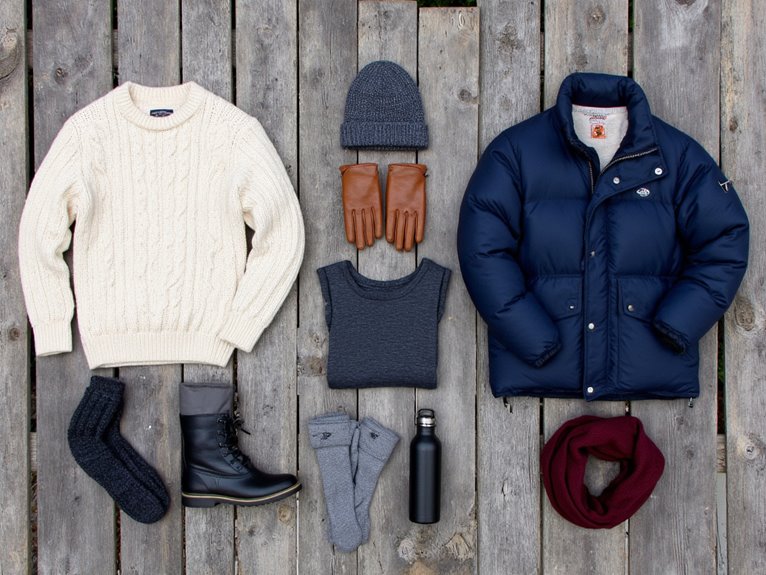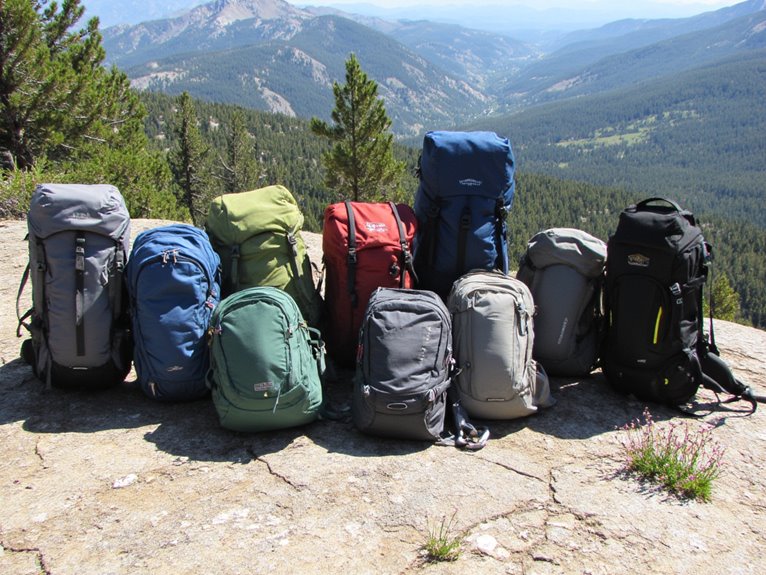Is It Ok to Hike in Jeans?
Hiking in jeans is not recommended due to denim's dense weave and thick fabric, which can lead to discomfort, chafing, and skin irritation. Restricted movement, wind, and cold can further exacerbate the issues, making it difficult to hike comfortably. Additionally, jeans can become heavy and restrictive when wet, and dark colors can obscure visibility, increasing the risk of accidents. Instead of suffering through these issues, there are better alternatives available, designed specifically for outdoor activities. Investigate the limitations of denim and discover how to optimize your hiking experience with technical fabrics that provide superior comfort, flexibility, and protection.
We are supported by our audience. When you purchase through links on our site, we may earn an affiliate commission, at no extra cost for you. Learn more. Last update on 15th January 2026 / Images from Amazon Product Advertising API.
Jeans Are Not Breathable
Denim's dense weave and thick fabric make it an inherently non-breathable material, trapping sweat and moisture next to the skin.
This can lead to discomfort, chafing, and even skin irritation during physical activity.
As a result, jeans are not an ideal choice for hiking, particularly in warm or humid conditions.
The fabric's inability to wick away moisture means that hikers may experience clamminess, blisters, and discomfort.
In addition, the retained moisture can also lead to a higher risk of fungal and bacterial infections.
For a comfortable and safe hiking experience, prioritizing breathable, moisture-wicking fabrics that allow for airflow and evaporation of sweat is crucial.
Cotton Retains Moisture Poorly
Cotton's propensity to retain moisture is a vital consideration when hiking in jeans.
The fabric's absorption rate, breathability, and drying time all contribute to a less-than-ideal hiking experience.
As we examine the implications of cotton's moisture retention, we'll delve into the specific challenges posed by its absorption rate, breathability issues, and slow drying time.
Moisture Absorption Rate
When hiking in jeans, the cotton fabric's ability to absorb moisture is limited, resulting in a slow drying rate that can leave you feeling clammy and uncomfortable.
This is because cotton has a low moisture absorption rate, which means it can only absorb a small amount of moisture before becoming saturated.
Once saturated, cotton retains moisture poorly, leading to a prolonged drying time.
This can be particularly problematic during physical activities like hiking, where excessive sweat can lead to discomfort and potentially even skin irritation.
As a result, hikers may find themselves feeling weighed down and uncomfortable, which can detract from their overall hiking experience.
Breathability Issues
The cotton fabric's poor breathability is further exacerbated by its tendency to retain moisture, causing a buildup of sweat and heat that can lead to discomfort and skin irritation during physical activities like hiking.
This can result in a range of unpleasant consequences for hikers.
Some key implications of cotton's breathability issues include:
Reduced evaporation rate: Cotton's moisture retention hinders the evaporation of sweat, making it difficult for the body to cool down efficiently.
Increased humidity: Trapped moisture creates a humid microclimate next to the skin, leading to discomfort and irritation.
Higher risk of blisters: Friction and moisture combine to increase the risk of blisters and skin abrasions.
Decreased performance: Cotton's breathability issues can impede a hiker's performance and endurance, making it more challenging to complete a hike comfortably.
Drying Time Concerns
In addition to its poor breathability, cotton's inability to dry quickly becomes a significant concern for hikers, as it can leave them feeling damp and clammy for extended periods.
When cotton absorbs moisture, it retains it, making it difficult for the fabric to dry rapidly. This can be particularly problematic on the trail, where moisture buildup can lead to discomfort, chafing, and even skin irritation.
Additionally, slow-drying fabrics can increase the risk of hypothermia in cold or wet conditions, making it essential for hikers to weigh the drying time of their clothing.
In contrast, synthetic fabrics like polyester and nylon are often designed to dry quickly, making them a more practical choice for hiking apparel.
Restricted Movement Affects Hike
How freely you can move ultimately determines the quality of your hike, and restricted movement can quickly turn a leisurely stroll into an exhausting ordeal.
Jeans, unfortunately, can be a major hindrance to unrestricted movement. The stiff fabric and rigid design of jeans can limit your range of motion, making it difficult to climb, scramble, or even walk comfortably.
Restricted movement can affect your hike in several ways:
Reduced stride length: Jeans can make it difficult to take long strides, forcing you to take shorter, more laborious steps.
Impaired balance: Restricted movement can throw off your balance, increasing the risk of tripping or falling.
Increased fatigue: When you're forced to work harder to move, you'll tire more quickly.
Decreased agility: Jeans can make it harder to react quickly to changing terrain or obstacles, putting you at greater risk of injury.
Jeans Offer No Wind Protection
When hiking in jeans, one of the most significant drawbacks is the lack of wind protection.
Unlike purpose-built hiking pants, jeans offer little to no barrier against gusty conditions, leaving the wearer exposed to biting winds.
This can quickly lead to discomfort, making an already challenging hike even more unpleasant.
Wind Whipping Through Fabric
Wind whipping through fabric is a significant issue with jeans, as the woven cotton or denim used to make them offers little to no resistance against gusts of air.
This means that even on moderately windy days, hikers wearing jeans can expect to feel the full force of the wind, which can be uncomfortable and even chilling.
Four key implications of wind whipping through jeans are:
- Cold spots: Wind can penetrate the fabric, making you feel cold and uncomfortable.
- Limited mobility: Wind resistance can make it harder to move quickly or freely.
- Noise distraction: The flapping and whipping of jeans can be distracting and annoying.
- Reduced focus: Dealing with wind-whipped jeans can divert attention from the hike itself.
Chilly Air Penetrates Denim
Denim, the primary material used to make jeans, lacks sufficient density and weave tightness to block chilly air, allowing cold temperatures to penetrate the fabric and reach the skin.
As a result, hikers wearing jeans are more susceptible to feeling the cold. This is particularly problematic in cooler weather conditions, where the body's ability to regulate its temperature is already compromised.
The lack of wind protection offered by denim means that hikers may experience discomfort and distraction from the cold, which can impede their ability to focus on the hike.
This limitation should be borne in mind when deciding what to wear on a hike.
Breezy Conditions Uncomfortable
In breezy conditions, the absence of wind protection in jeans leaves hikers exposed to the elements, amplifying the discomfort and chill they may already be experiencing.
This can be particularly problematic on mountainous trails or coastal routes where winds are stronger. When jeans are unable to shield against gusts, hikers may need to stop and adjust their clothing or seek shelter, disrupting their pace and momentum.
Some notable drawbacks of jeans in breezy conditions include:
Reduced mobility: Jeans can become stiff and restrictive in windy conditions, making it difficult to move freely.
Increased fatigue: Constantly battling the wind can lead to exhaustion and decreased endurance.
Cold stress: Prolonged exposure to wind can cause hypothermia, especially in colder climates.
Reduced visibility: Wind-blown debris or snow can reduce visibility, making it challenging to navigate the trail.
Water and Mud Are Enemies
When hiking in jeans, water and mud can be particularly detrimental to the fabric, causing it to weigh you down, chafe, and lose its shape.
Waterlogged jeans can add significant weight, making every step a struggle. Mud, on the other hand, can stain and stiffen the fabric, reducing its flexibility and comfort.
Additionally, mud can also hide hidden obstacles like rocks and roots, increasing the risk of trips and falls.
To mitigate these risks, it's essential to take precautions when hiking in jeans, such as avoiding wet and muddy areas, using waterproofing treatments, and packing spare clothes in case of an emergency.
Jeans Can Chafe and Rub
Hiking in jeans can cause friction and discomfort due to the rigid fabric, leading to chafing and rubbing, especially in areas prone to movement, such as the thighs, knees, and ankles.
This can lead to painful blisters and discomfort during and after the hike.
To minimize the risk of chafing and rubbing, consider the following:
Wear a base layer: A breathable base layer can help reduce friction between your skin and jeans.
Apply anti-chafe products: Apply products containing ingredients like aloe vera or tea tree oil to high-friction areas.
Wear gaiters or leg gaiters: These can help reduce friction between your jeans and boots.
Choose stretchy jeans: Opt for jeans with a bit of stretch to reduce friction and discomfort.
Insects and Bugs Love Denim
Denim's thick, dense weave creates an ideal habitat for insects and bugs, making jeans a magnet for unwanted critters on the trail.
Mosquitoes, ticks, and chiggers are particularly drawn to denim, and can easily burrow into the fabric. This can lead to discomfort, itching, and even allergic reactions.
Additionally, the tight weave of denim can trap moisture, creating a humid environment that attracts insects.
When hiking in jeans, it's not uncommon to find unwanted hitchhikers clinging to your pants, making for an uncomfortable and frustrating experience.
Visibility and Safety Concerns
Frequently, the dark color and loose fit of jeans can obscure visibility, making it more difficult to spot potential hazards on the trail, such as rocks, roots, and slippery surfaces. This reduced visibility can lead to accidents and injuries.
Additionally, jeans can also hinder safety in other ways.
Loose-fitting jeans can obstruct your view, making it harder to detect potential dangers.
Dark jeans can blend in with the surroundings, making it challenging to see rocks, roots, and other hazards.
Long or loose jeans can increase the risk of tripping over your own pant legs.
If you're focused on managing your clothes, you'll have less attention for the trail ahead.
These visibility and safety concerns are essential to think about when deciding whether to hike in jeans.
Better Alternatives Exist
Fortunately, outdoor enthusiasts can opt for technical fabrics and designs that provide superior comfort, flexibility, and visibility, making them a more suitable choice for hiking.
These alternatives often feature moisture-wicking properties, breathability, and four-way stretch, allowing for a full range of motion.
Moreover, many hiking pants and leggings are designed with built-in UPF protection, reducing the risk of sunburn and skin damage.
Additionally, some fabrics are treated with insect-repellent technology, providing an extra layer of protection against biting insects.


